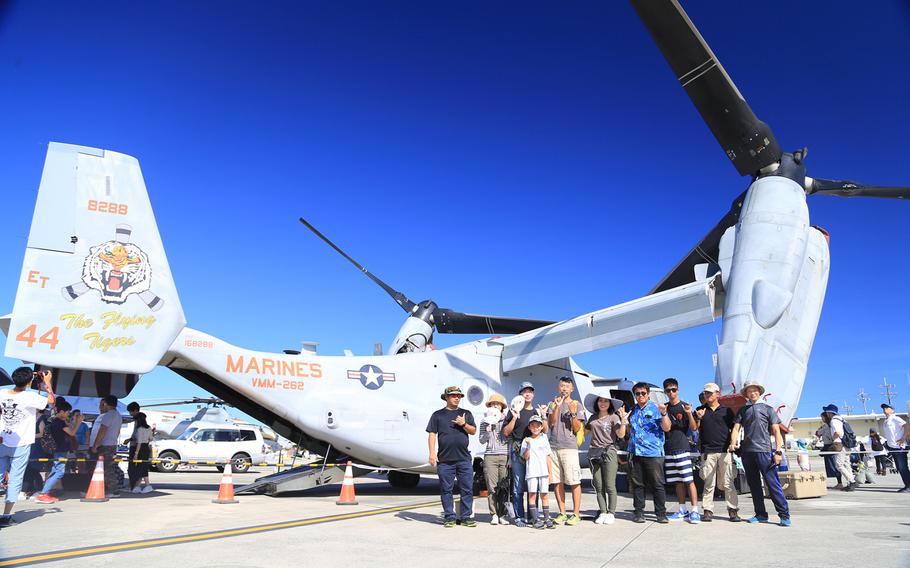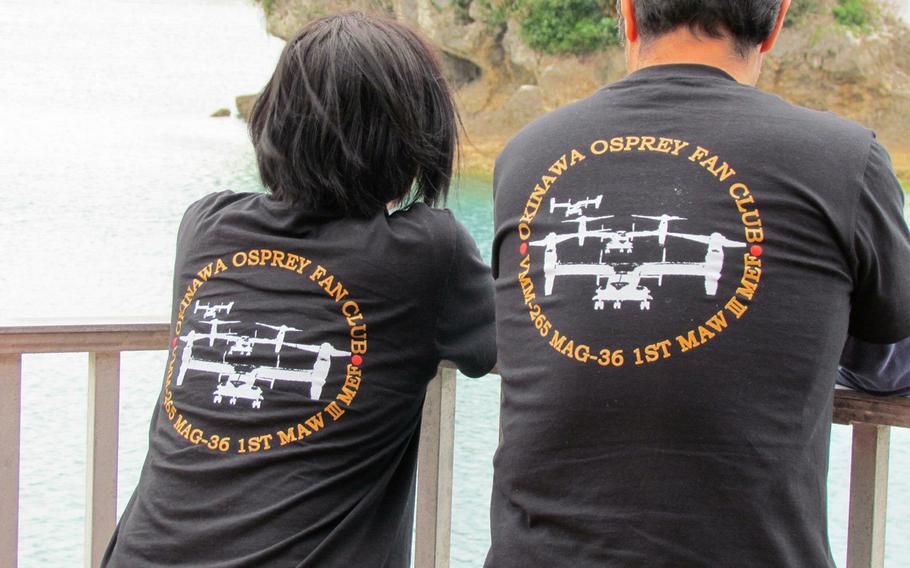
Japanese fans pose with an MV-22 Osprey tilt-rotor aircraft on Marine Corps Air Station Futenma July 8, 2018. (Aya Ichihashi/Stars and Stripes)
MARINE CORPS AIR STATION FUTENMA, Japan — On an island where locals often seem fearful of U.S. military aircraft, a group of Okinawan aviation buffs has fallen in love with the MV-22 Osprey.
The Okinawa Osprey Fan Club, whose members attend the annual Futenma Flight Line Fair and help clean up outside the base, has more than 13,000 Facebook followers who post photographs and articles about their favorite flying machines.
Group members wear T-shirts with images of Ospreys and aren’t shy about expressing their admiration for the hybrid aircraft, which can take off like a helicopter, and then tilt rotors to fly long distances as fixed-wing planes.
The group is the polar opposite of anti-base protesters who gather regularly outside U.S. facilities on Okinawa and mainland Japan, holding photographs of crashed and damaged aircraft.
Protests and complaints greeted the aircraft’s arrival on Okinawa in July 2012, as the Osprey replaced decades-old Marine Corps helicopters.
The protests have continued, spurred by incidents such as the Dec. 2016 ditching of an Osprey into the sea off the Okinawan coast. In February, the commander of one of Okinawa’s two MV-22 Osprey squadrons was fired, nearly six months after a crash off Australia’s eastern coast killed three Marines.
Anti-base activists chanted “No Osprey” in Tokyo when a detachment of Air Force CV-22 Ospreys began arriving at Yokota Air Base in April.
The protests present a sharp contrast with the fan club members who smiled and posed for photos with one of the aircraft at the Futenma Flight Line Fair on Sunday.
One fan, who identified himself only by his last name, Yamashiro, had plenty of praise for the aircraft.
“Osprey has the best technology,” he said. “Even if one engine breaks the other can compensate and the design of the aircraft is just amazing.”
Osprey fans are as effusive in their online praise.

Japanese people wear T-shirts emblazoned with images of the iconic MV-22 Osprey tilt-rotor aircraft. Courtesy of Okinawa Osprey Fan Club (Courtesy of Okinawa Osprey Fan Club)
Katsunori Tsuji, for example, commented recently on the fan club page that he likes the Osprey “…because it looks so cool.”
Kazuaki Matsuura wrote that he’s excited about the aircraft’s future.
“It’s still in the middle of development and we can expect many other types of Ospreys in the future,” he wrote on Facebook.
In April, Rie Kido posted about her memories of Marine Corps Ospreys bringing relief to survivors of the 2016 Kumamoto earthquakes on Japan’s southern island of Kyushu.
“I remember being there as a volunteer and that Ospreys flew above me, and it gave me a sense of comfort and relief from instability; and I truly appreciated their support from the bottom of my heart,” Kido wrote. “Not only were people not complaining about their presence there, but they were also appreciating their support.”
The fan club’s founder, Mikako Miyagi, a professional interpreter from Naha, Okinawa, said she started the group in 2012 to promote positive stories about the Osprey.
Miyagi has watched and read plenty of local media reports about the supposed dangers of the aircraft, but after doing her own research she decided it had gotten a bad rap.
The Osprey could be a useful disaster relief tool for the Japan Self-Defense Force, which plans to purchase its own fleet of the tilt-rotor aircraft, she said.
“We’re not right-winger nor left-winger,” she said of the fan club in a recent phone interview. “We are here to help represent the good side of Marines and sailors on Okinawa that none of the media sheds light on.”
The Osprey fans have befriended American military personnel, she said, noting that she and her husband attended a Marine Corps Birthday ball on Futenma.
Miyagi’s pro-Osprey stance put her at odds with one of the anti-base activists when she arrived at Futenma with her family, for an event the Marines organized to show locals their aircraft a few years ago.
When the family’s vehicle approached the base a elderly female protestor yelled, “Why are you bringing your children to show them the Osprey?” she recalled.
The woman hit Miyagi on the head with a “No Osprey” sign and kicked her car’s rear door close to where her two daughters were sitting, she said.
“Excited protesters surrounding the on-base school bus and screaming at innocent children isn’t the right thing to do.” she added. “This is why our group will not counterprotest. Protestors are too violent and dangerous.”